With contributions by Paola Ricciardi, Giovanni Pescarmona, Daniel Pett, Victoria Sutcliffe and Chris Titmus
The Inspire2020 exhibition at the Fitzwilliam Museum in Cambridge, UK (December 2019–March 2020) brought together artwork by schoolchildren, the interpretative possibilities of augmented reality (AR), and scientific, educational and art-historical expertise at the University of Cambridge to explore one of museum’s best-known Renaissance pictures: Jacopo del Sellaio’s engaging narrative of the mythical romance between Cupid, matchmaker to the gods of pagan antiquity, and the mortal Psyche, painted in Florence in the 1470s.
Story of Cupid and Psyche (first panel; c. 1470–80), Jacopo del Sellaio. Fitzwilliam Museum, Cambridge

The Octagon gallery display celebrated the creativity of local schools by showing children’s art alongside Sellaio’s painting. The project, modelled on the National Gallery’s Take One Picture scheme, began in early 2019 with exhibition curator Kate Noble engaging schools across Cambridgeshire through teacher-training events led by museum educators and artists from the charity AccessArt. Having developed visual literacy skills around looking at and making art, teachers then studied Sellaio’s painting in the classroom: in total around 3,800 children participated. Back at the museum and Hamilton Kerr Institute, inspired by the children’s focused engagement with the artist’s materials and techniques, a team of heritage scientists, conservators and imaging specialists undertook their own research on the panel using non-invasive analytical protocols pioneered during recent Fitzwilliam projects on illuminated manuscripts and medieval sculpture. As well as pigment analysis, the team took X-ray and Infrared (IR) Reflectography scans, clarifying the panel’s structure and – as we shall see – revisions in the underdrawing.
Upscaling Cupid and Psyche Collaboratively by Year Fives at Linton Heights Junior School, Cambridge
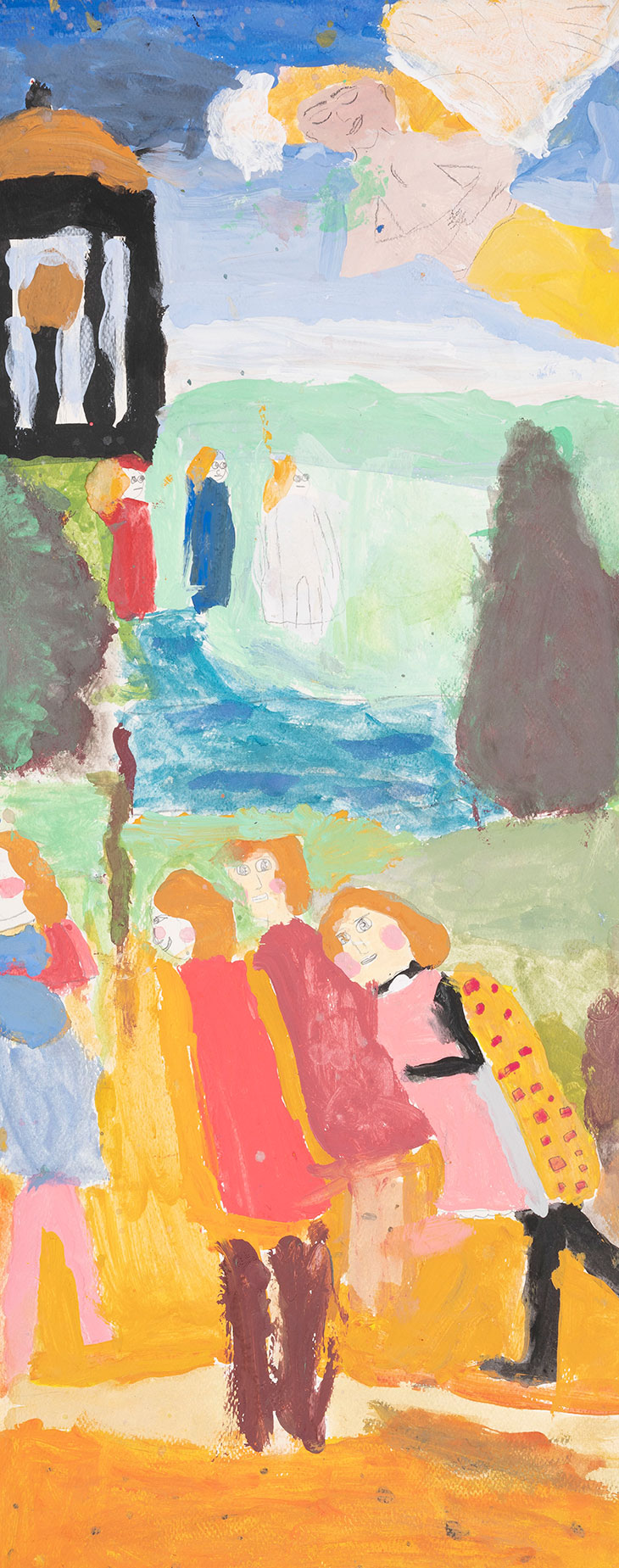
At the same time, links with scholars in Florence suggested the possibility of extending the display through digital interpretation. Working with cultural heritage app developer Maggioli Musei, University of Florence researcher Giovanni Pescarmona had already created a smartphone app for the Museo Bandini in Fiesole using AR to provide iconographic analysis, conservation data, and montages with companion pieces in other collections. Pescarmona and his colleagues now adapted their Bandini template for the Inspire2020 display. The new ‘Ways of Seeing’ smartphone app locks on to the artwork when the phone is held before the painting. The navigation bar at the bottom of the screen offers three overlay modes: ‘Microscopy’ (high magnification photography), ‘Infrared’ and ‘X-ray’.
The zooming level of the overlay images synchronises with the user’s movements, as if the phone itself were scanning the work in real time. Each mode highlights points of interest with circular hotspots that rhythmically fade in and out of view: tapping these accesses magnified details and explanatory text. The ‘Microscopy’ mode explores different pigments, ‘Infrared’ focuses on pentimenti in the underdrawing, and ‘X-ray’ picks out details like metal nails within the wooden structure. The interface thus combines curated content with user-led exploration of the technical data.
For now available only in English on the Fitzwilliam Museum own’s smartphones (which visitors may use), the app launched in February and will return to accompany Sellaio’s painting when the museum reopens after the current shutdown. The app is not unprecedented: comparisons include the Prado’s Second Canvas, the British Museum’s A Gift for Athena and DymonLab’s Augmented Artefacts project. AR offers much more than a digital alternative to the museum label or catalogue entry. ‘Ways of Seeing’, for example, empowers viewers with the latest technical data and can itself function as a research tool. As well as delving into paintings, AR interpretation can step back and place artworks in context, as with the recently published Hidden Florence 3D app for the National Gallery. AR has a number of advantages over virtual reality (VR) for museum interpretation: it is cheaper, has a lighter footprint, and anecdotal evidence suggests that – unlike the isolated experience associated with VR – people engage with AR together. Well-designed AR also retains the focus on the original artwork and increases visitor engagement with it.
Installation view of ‘Inspire2020’ in the Octagon Gallery at the Fitzwilliam Museum, Cambridge (10 December 2019–22 March 2020)
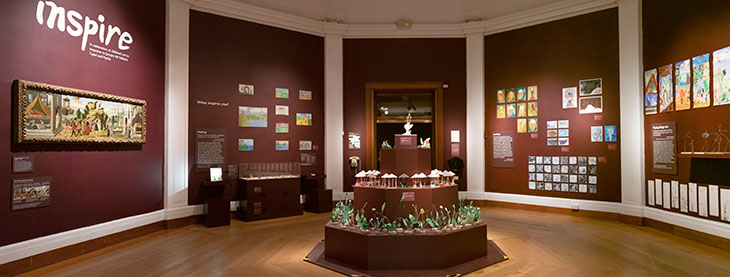
Inspire2020 has shed new light on the display’s centrepiece, an important work by the Florentine artist Jacopo del Sellaio (c. 1441–1493), whom Vasari tells us trained alongside Botticelli in Filippo Lippi’s workshop. Sellaio is best known for his domestic paintings and the Fitzwilliam picture is either a spalliera panel (a backboard for a piece of furniture or set within wainscoting) or the front of a cassone chest (a genre of decorated storage box commissioned for newly-wed Florentines). The Fitzwilliam painting depicts episodes from the story of Cupid and Psyche, derived from Lucius Apuleius’s Golden Ass, a second-century work sometimes described as the only novel to survive from the classical world. The story begins with Apollo conceiving Psyche with her mother, followed by Cupid falling in love with the adult Psyche at first sight. The story unfolds through a complex series of prophecies, tasks and deceptions as the lovers struggle to overcome the anger of Cupid’s mother Venus at their liaison. The Fitzwilliam panel tells the first half of the story; the concluding half through to Psyche’s acceptance among the gods is depicted on a companion panel now in a private collection in New York.
Story of Cupid and Psyche (second panel; c. 1470–80), Jacopo del Sellaio. Photo: The Picture Art Collection/Alamy Stock Photo

The story of Cupid and Psyche would become a mainstay of European mythological painting after Raphael’s influential scheme at the Farnesina in Rome (1517–20), but there are only a handful of 15th-century versions. The Golden Ass was lost for most of the Middle Ages and knowledge of Apuleius’s novel limited to heavily reinterpreted summaries in other works. The Fitzwilliam panel and its New York pendant constitute one set in a closely-knit sequence of three pairs of domestic panels painted in Florence during the Quattrocento depicting the story, recently studied in detail by Jerzy Miziołek. One of these pairs, dated c. 1490 and also attributed to Sellaio, is divided between the Museum of Fine Arts in Boston and the Abegg-Stiftung in Switzerland. This set reprises closely the Fitzwilliam-New York pair but, as Miziołek has shown, incorporates additional elements taken from Botticelli’s famous Primavera, probably commissioned for Lorenzo di Pierfrancesco de’ Medici for his marriage to Semiramide Appiano in 1482 and recorded in the Palazzo Medici in 1498.
Story of Cupid and Psyche (first panel; c. 1470), Master of the Argonauts. © Staatliche Museen zu Berlin, Gemäldegalerie/Jörg P. Anders
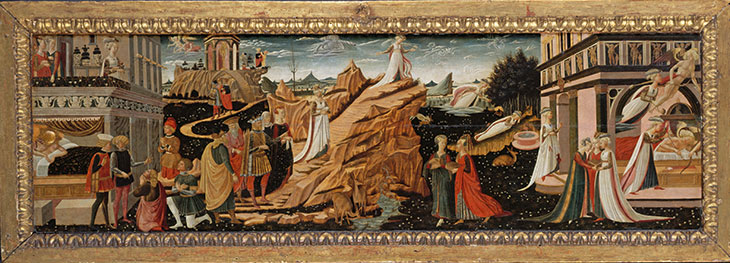
Story of Cupid and Psyche (second panel; c. 1470–75), Master of the Argonauts. © Staatliche Museen zu Berlin, Gemäldegalerie/Jörg P. Anders

Medici links are even more explicit on the earlier pair of panels both now in the Bode Museum in Berlin. In the first half of the story the family’s device of the diamond ring and feathers appears fashioned in topiary on Psyche’s loggia and the Medici coat of arms with the distinctive red balls (palle) on gold are set above the doorway to Cupid’s palace, recalling the enormous escutcheon mounted on the exterior of Palazzo Medici. Miziołek dates these panels to c. 1470, close to the publication of the full text of the Golden Ass in Rome in 1469. All scholars agree that the 15th-century Florentine versions of the story depend on Apuleius’s original novel, rather than just the allegorised and Christianised summaries by Martianus Capella and Fulgentius that circulated during the Middle Ages, or the heavily moralised version incorporated into Boccaccio’s Genealogy of the Pagan Gods. By the 15th century several of the available manuscripts of Apuleius’s complete text were concentrated in the hands of the Medici.
The panels in Berlin belong to a group of paintings assigned to the anonymous Master of the Argonauts whose identity remains a matter of connoisseurial debate. Everett Fahy speculated that he may be the painter Cosimo Rosselli’s younger brother Francesco; Miziołek, meanwhile, has argued that the cassoni in the Bode can be identified as youthful works by Jacopo del Sellaio. Even if he did not paint these narratives himself, Sellaio must have had access to them when designing the picture now at the Fitzwilliam and its companion in New York: the choice of narrative episodes and compositional structure are simply too close to allow for anything but a direct derivation. It is perhaps unsurprising, therefore, that the more significant pentimenti detected during the infrared scanning of the panel in Cambridge can be related to departures from its prototype in Berlin. For example, the IR scan detected several revisions in the flying figure of Cupid admiring Psyche at the start of the story, with an outstretched wing to the left visible in the underdrawing but then discarded in the finished painting. This figure is absent from the Berlin version, so Sellaio may have been devising him here for the first time. A second pentimento on the Cambridge painting is visible in the nearby tempietto where Psyche’s parents retire to consult an oracle over their daughter’s fate: the IR scan shows at least two, possibly three kneeling figures between the columns. This feature corresponds with the Berlin version, in which Psyche’s mortal stepfather kneels beside the oracle’s pavilion. The new technical evidence suggests that Sellaio considered retaining this episode before simplifying his narrative composition.
Detail showing the flying Cupid in the Infrared reflectogram of Jacopo del Sellaio’s Story of Cupid and Psyche at the Fitzwilliam Museum, Cambridge
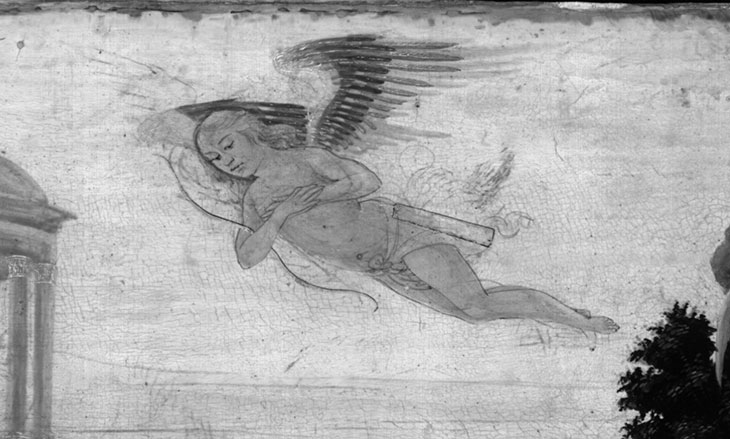
The IR scan also revealed that the facade of Cupid’s palace was initially conceived with a series of three arched niches, the central one filled with a standing figure of Cupid, wings extended and holding a lance. Here too, cross-referring to Berlin clarifies Sellaio’s process of rethinking and revision. In the earlier version Cupid’s palace is more richly appointed with a frieze of winged putti holding weapons and shields. Returning to the IR evidence for the Fitzwilliam painting, the sketched figure also holds an escutcheon of the same chanfron format in front of his legs like the frieze of Cupids in the Berlin painting, suggesting that he was a statue rather than an addition to the continuous narrative. Through these revisions, the new IR evidence sheds considerable light on the relationship between the Fitzwilliam picture and its ‘model’ in Berlin, confirming that the process of adapting the earlier narrative scheme was fluid and creative. The three pentimenti discussed here are highlighted for the visitor through hotspots in the app’s ‘Infrared’ mode.
Detail showing the facade of Cupid’s palace in the Infrared reflectogram of Jacopo del Sellaio’s Story of Cupid and Psyche at the Fitzwilliam Museum, Cambridge
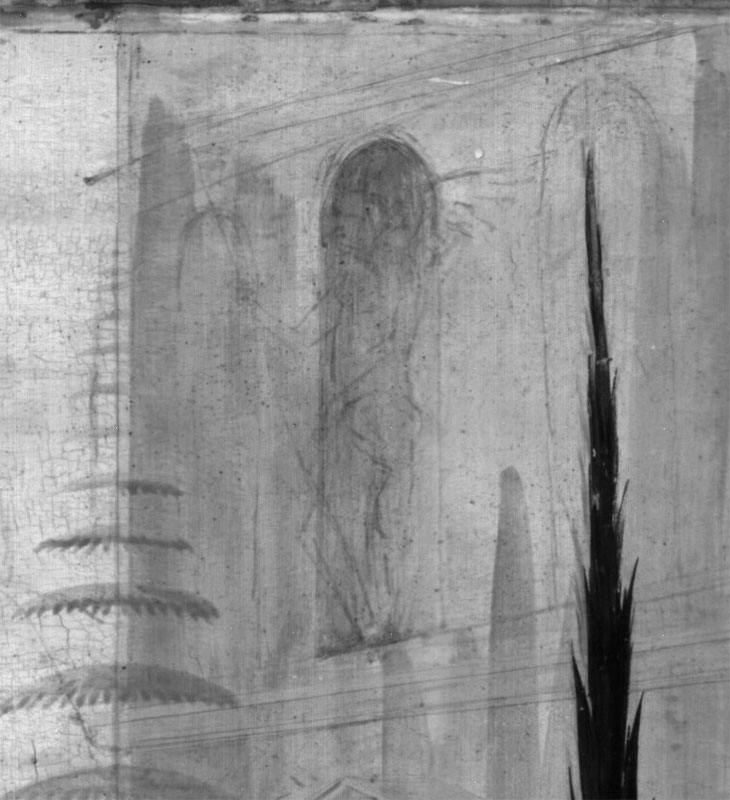
The ghostly statue of Cupid bearing a coat of arms that emerges from the IR scan also recalls the Medici shield above the doorway to Cupid’s palace in the Berlin version. Sellaio omitted any overt heraldry in the Cambridge painting as far as we can tell, but there are more subtle clues as to who its patron may have been. Miziołek is the only scholar so far to have noted the image of a bird embroidered on the cloak of one of Psyche’s suitors, identifying it as the falcon device of Filippo Strozzi, the wealthiest man in Florence after the Medici themselves. The detail is reinforced by the suitor’s companion to the left with a bird of prey perched on his gloved left hand. The emblem (or impresa) functioned as a rebus for the Strozzi – the Italian word for falconer is ‘strozziere’ – and appears on medals, furniture and textiles associated with the family, where the bird holds a banderole combined with an upturned cartrap spike or a branch of wood.
But closer analysis of the panel shows that Sellaio’s falcon clasps a different object: a circular ring through which a banderole ripples. Rather than a Strozzi motif, this should be read instead as the Medici device of a falcon gripping a diamond ring and banderole bearing the motto SEMPER (‘always’). The falcon with a ring is usually understood as a personal impresa of Piero ‘il Gottoso’ (‘the Gouty’) de’ Medici who died in 1469, but Adrian Randolph has observed that ‘the Medici do seem to have been rather liberal in sharing their devices with one another’. The ring motif would certainly have suited an image intended to celebrate a marriage. Deciphering the letters SP (perhaps a contraction of SEMPER, or a reference to a patron’s name?) above the falcon may reveal more. Meanwhile one of the other suitors wears a cloak embroidered with a nude female figure holding an object in her right hand, perhaps a burning torch. Luke Syson suggests that this may be Hymen, the classical deity of marriage, whose most common attribute was a torch or burning cornucopia, or alternatively Venus herself in that role.
Detail showing Pysche’s suitors (with a falcon device embroidered on the cloak of the foregrounded figure to the right, and a nude (possibly carrying a torch) on the cloak of the foregrounded figure to the left) in the panel of Jacopo del Sellaio’s Story of Cupid and Psyche at the Fitzwilliam Museum, Cambridge
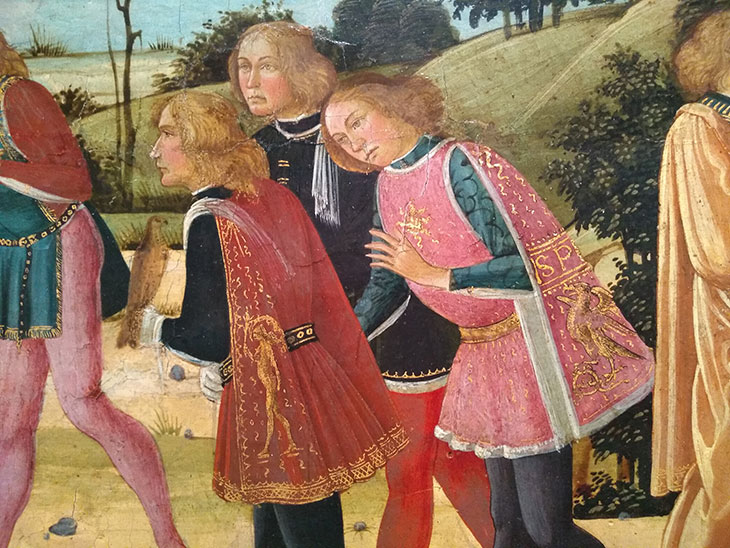
Further research on these emblems may clarify the patronage of the Fitzwilliam panel but the newly identified presence of the Medici’s falcon device on the picture matches Luisa Vertova’s analysis of Medicean allusions on its companion in New York. Here Sellaio departed from his Berlin model by introducing an episode from Apuleius’s story in which the wild god Pan consoled Psyche after she had tried to drown herself. Vertova argued that the addition was best explained by Lorenzo de’ Medici’s well-documented interest in the mythological figure of Pan, concluding: ‘Once more, we find ourselves in Medicean circles’. It thus seems likely that Jacopo del Sellaio’s story of Cupid and Psyche split between Cambridge and New York was either a commission for Florence’s first family, the Medici, or another lineage closely associated with them. Indeed, the consistent connections between all three pairs of panels and the Medici suggest that the story of Cupid and Pysche was closely associated with the family, and perhaps even reserved for them.
The ‘Ways of Seeing’ app represents the culmination of a year-long collaborative research project where seeing an artwork through the creative responses of children has stimulated experts in the fields of art history, heritage science, museum education and digital interpretation to look at the painting with fresh eyes. The new technical analysis allows us to understand the creative relationship between the Cambridge and Berlin panels in much greater detail. Its innovative presentation in a smartphone app now invites museum visitors to look beyond the painting’s surface and explore the artwork’s themes, processes and materials for themselves. At a broader level, the new app opens an exciting pathway for the integration of technical data within the gallery experience. ‘Ways of Seeing’ focuses on one painting but the template is readily scalable. It could easily be extended to cover entire collections, transforming the public awareness and accessibility of the scientific analysis that now shapes the study of medieval and Renaissance panel painting.
The ‘Ways of Seeing’ app was part-funded by a grant from the University of Cambridge’s Arts and Humanities Impact Fund.
Donal Cooper is Senior Lecturer in Italian Renaissance art in the Department of History of Art at the University of Cambridge. Kate Noble is Education Officer at the Fitzwilliam Museum and curator of Inspire 2020.
Further reading:
Campbell, Caroline (ed.), Love and Marriage in Renaissance Florence: The Courtauld Wedding Chests (Paul Holberton: London, 2009)
Carver, Robert H.F., The Protean Ass: The Metamorphoses of Apuleius from Antiquity to the Renaissance (Oxford University Press: Oxford, 2007)
Fahy, Everett, ‘The Argonaut Master’, Gazette des beaux-arts 114 (December 1989), pp. 285–300
Krohn, Deborah L., ‘Jacopo del Sellaio’, catalogue entry in Art and love in Renaissance Italy, ed. Andrea Bayer (The Metropolitan Museum of Art: New York and Yale University Press: New Haven and London, 2008), pp. 293–295
Miziołek, Jerzy, Renaissance Weddings and the Antique: Italian Domestic Paintings from the Lanckoronski Collection (‘L’Erma’ di Bretschneider: Rome, 2018), esp. pp. 189–221
Noble, Kate, ‘Picture Thinking: The Development of Visual Literacy in Young Children’, Engage 38, Special Issue on Visual Literacy (2016), pp. 40–51
Randolph, Adrian W. B., Engaging Symbols: Gender, Politics, and Public Art in Fifteenth-Century lorence (Yale University Press: New Haven and London, 2002)
Schubring, Paul, ‘Zwei Cassonetafeln mit Apuleius’ Märchen von Amor und Psiche’, Zeitschrift für Bildende Kunst 27 (1916), pp. 315–320
Pescarmona, Giovanni, ‘Augmented Reality and Renaissance Painting: An AR Experience for the Fitzwilliam Museum in Cambridge’, in Culture and Computer Science: Extended Reality, Johann Habakuk Israel, Christian Kassung, and Jürgen Sieck (eds.) (vwh-Verlag, Glückstadt, forthcoming 2020)
Vertova, Luisa, ‘Cupid and Psyche in Renaissance painting before Raphael’, Journal of the Warburg and Courtauld Institutes 42 (1979), pp. 104–121


